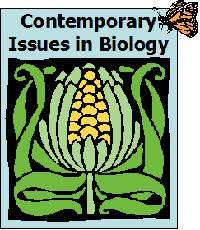
Week 3, Chapter 2 -- Freelance Writer Sample Answer
Course home | Weekly schedule | Announcements | Instructor Info | Desire2Learn | MasteringBiology® | Honor Code | FAQs | HELP!
 |
Week 3, Chapter 2 -- Freelance Writer Sample AnswerCourse home | Weekly schedule | Announcements | Instructor Info | Desire2Learn | MasteringBiology® | Honor Code | FAQs | HELP! |
This is a fictional installment of the cartoon, The Magic School Bus.
"Ok, class, today we are going to take a special magic tour to learn about prokaryotic and eukaryotic cells and cancer," says Mrs. Frizzle to the class. "Cancer is very important to learn about because it affects one in seven Americans," she continues. "Before we get going, can anyone tell me the difference between prokaryotes and eukaryotes?" she asks. "I can, I can!" the class responds. "Carlos, you tell us," says Mrs. Frizzle. "Prokaryotic cells are cells that have no nucleus or other membrane bound organelles," he states, "and eukaryotic cells do have membrane bound organelles." "Phoebe," says Mrs. Frizzle, "What are organelles?" "They are internal structures of the cell that carry out specific functions, like the nucleus is the site for our genetic material, or DNA," she answers. "Very good," says Mrs. Frizzle. Dorothy adds, "And the mitochondria are energy producing organelles because they produce ATP."
"What are some examples of prokaryotic versus eukaryotic cells?" asks Mrs. Frizzle. Keesha answers, "Bacteria are prokaryotes because they do not have a nucleus, nor is their DNA in a separate membrane bound compartment. Amoebas, mushrooms, plants and animals are all eukaryotes because they have membrane bound organelles and a nucleus." "Very good, Keesha," says Mrs. Frizzle.
"Can someone tell us about the structure of the cells?" asks Mrs. Frizzle. Ralphie replies, "Both prokaryotic and eukaryotic cells are surrounded by the plasma membrane, which encloses structures inside of the cell. This is a semipermeable membrane, allowing the important nutrients to move in and out of the cell. They are made up of a phospholipid bilayer, proteins, cholesterol and sugar chains, all of which have specific functions. Plants and bacteria also have cell walls. The ones in plants are made of the polysaccharide cellulose." "Very nice, Ralphie, you have really been doing your homework," compliments Mrs. Frizzle.
"Now, class," asks Mrs. Frizzle. "Who can tell me about cancer?" "Cancer is caused by cells replicating when they are not supposed to," pipes up Arnold. "Sometimes this buildup of cells leads to a tumor, which can invade other tissues," he continues."Exactly," replies Mrs. Frizzle. She tells the class, "A recent study showed that cancer cells are also like regular cells in that they need building materials for their cell walls. Cells must get their timing right when the membrane is made. If this timing is off, then the cell cannot function properly. There is a special protein called SREBP1 that regulates the synthesis of new lipids in the wall. Scientists have figured out that if they remove the SREBP1 protein before the cell replicates, then the cancer cells cannot reproduce because they can not build new cell walls," explains Mrs. Frizzle."How ingenious!" she exclaims. "Cells are kind of like houses, and lipids are like the bricks. Without them, cells can not function."
"Are you ready for our adventure today? Let's get in our magic bus and take a tour inside a bacterium, a eukaryotic cell, and a cancer cell so that we can see firsthand how different and similar they are! If we are lucky, we might even get to venture into a tumor! Wahoo! Take chances, make mistakes, and get dirty!" ends Mrs. Frizzle with her famous quote.
Author unknown. "No cell walls, no new cancer cells." August 2, 2006. http://www.brightsurf.com/news/headlines/25668/No_cell_walls_no_new_cancer_cells.html. Downloaded August 15, 2006.
Belk, C. and V. Borden. 2007. Biology: Science for Life, Second Edition. Pearson Prentice Hall. Upper Saddle River, NJ.
[Back to Freelance Writer Assignment]
[Sample assignment contributed by Raelynn Deaton]